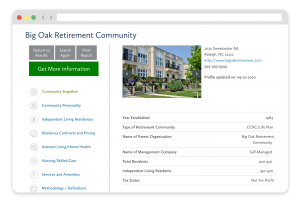As the senior living industry continues to evolve, much of the conversation has focused on two major trends: older adults choosing to remain in their current homes (aging in place) and the growing popularity of active adult communities that appeal to younger retirees. But there’s a less obvious, yet potentially more disruptive force also quietly gaining momentum across the country: the accessory dwelling unit (ADU).
Why ADUs are gaining ground
Also known as “granny flats,” “in-law units,” or “backyard cottages,” ADUs are small, secondary homes built on the same lot as a single-family residence. And they’re not just a flash-in-the-pan housing trend. They are becoming a more mainstream housing option for older adults that could ultimately become a major factor in where and how some choose to live during their retirement years.
Several trends are converging to make ADUs more appealing — and more accessible — to older adults than ever.
Legal and regulatory shifts
In the past five years, dozens of states and cities have relaxed zoning laws to allow ADU development.
For example, California legalized ADUs statewide in 2017 and passed additional laws in 2019 and 2020 to streamline permitting and reduce barriers. As a result, the state saw over 23,000 ADU permits issued in 2021, up from just 1,300 in 2016 — a 1,670% increase. Similarly, Oregon, Vermont, New Hampshire, Washington, and Colorado have all passed legislation encouraging or mandating ADU-friendly zoning.
An aging population’s housing needs
According to the U.S. Census Bureau, by 2034, adults 65 and older will outnumber children under 18 for the first time in U.S. history. Furthermore, approximately 10,000 Americans turn 65 every day, and nearly 75% of them say they want to “age in place,” i.e., remain in their own home as they grow older, according to 2024 AARP data.
However, a report from the Harvard Joint Center for Housing Studies reveals that a very small percentage of U.S. housing units are equipped with all five of the key universal design features that make aging in place feasible and safe. These include no-step entryways, single-floor living, extra-wide doorways and hallways, accessible electrical controls, and lever-style door and faucet handles.
ADUs offer a simple solution to these and other sometimes-unique housing needs of older adults. As a small, highly customizable, age-friendly home built close to family, ADUs also allow for informal family caregiving and social connection without moving to a group living environment.
>> Related: Senior Living Cooperatives Explained
Cost and flexibility factors
Based on the latest data from the Genworth Cost of Care Survey, the average annual cost for a resident of an assisted living in the U.S. is a staggering $72,924. And that’s just an average; depending on your location, the cost may be lower or even higher.
Contrast that to an ADU, which can be custom-built to an older adult’s unique specifications for $150,000 to $300,000, on average, for 600 to 1,200 square feet of living space, depending on location and design. What’s more, that construction cost is a one-time investment, which will likely yield property value return in the future.
Additionally, families can use ADUs flexibly. Yes, they serve as aging-in-place housing for loved ones, but they can also be used as a revenue-generating rental unit, a guest house, or even temporary caregiver housing.
>> Related: Crunch the Numbers: Aging at Home vs. Moving to a CCRC
Why the senior living industry should pay attention to ADUs
While “aging in place” and 55+ active adult communities are cited as key competitors to more traditional retirement communities, ADUs represent a hybrid senior living model that may combine the best of both worlds. With an ADU, older adults can enjoy independence, affordability, proximity to family, safety measures, and long-term flexibility.
Indeed, ADUs challenge the traditional senior living value proposition in several ways.
| Common senior living community feature | ADU alternative |
| Onsite care services | Family caregivers and home-based services |
| Sense of community | Proximity to loved ones and neighborhood integration |
| Accessibility features | Highly customizable single-story design |
| Resident safety and oversight | Technology-enabled remote monitoring options |
| Sometimes-high entrance and/or monthly fees | No monthly rent if family-owned |
>> Related: Family Caregiving Can Present Stressful Challenges
A strategic imperative for the senior living industry
A growing portion of prospective retirement community residents are considering the broader array of housing options that are now available to them, including the possibility of building or moving into an existing ADU. To stay relevant in this shifting housing ecosystem, senior living providers should begin rethinking their role. They must learn to “sell” themselves to prospects as not just housing providers, but as service and technology hubs for older adults, wherever they choose to live.
For instance, a strategic move for a retirement community may include exploring potential partnerships with municipalities or developers. Together, they could offer age-friendly home design templates, consultation services, or even a lease-to-own ADU model. Such collaboration enables retirement communities to position themselves as a trusted voice on aging options by educating families about ADUs — supportive of, not competitive with, multigenerational living.
Another option for retirement communities to remain relevant is by expanding their off-site services. The “CCRC without walls” or “continuing care at home” concept is a prime example. With this model, continuing care retirement communities (also called life plan communities) offer subscription-based care coordination, wellness programs, or tech-enabled support systems that serve older adults living outside of the CCRC campus, such as in ADUs.
Some senior living providers may even want to explore the possibility of developing their own small-scale ADU-style “villages.” This would require staying on top of local legislation and zoning changes within certain markets but could present a promising revenue stream as part of an organization’s continuum of care offerings.
>> Related: Continuing Care at Home Gives Older Adults the Best of Both Worlds
A new kind of senior living competition
ADUs are no longer the niche housing option they once were. As state and local governments embrace them to combat housing shortages, and as older adults and their families seek more flexible, affordable “aging in place” options, these small dwellings could reshape the senior living industry in a profound way.
Indeed, the biggest threat to the traditional retirement community model isn’t that people won’t choose senior living. It’s that they now have a broader array of viable, attractive alternatives than ever before.
In many ways, ADUs may well embody the future of senior living, particularly as the final cohort of baby boomers retire. Many people in this generation are looking for retirement housing options that are personalized, flexible, and family-oriented, and that allow for ample social interaction. As a result, the challenge for the senior living industry isn’t how to compete with ADUs — it’s how to complement and adapt to this rapidly expanding model.

FREE Detailed Profile Reports on CCRCs/Life Plan Communities
Search Communities






